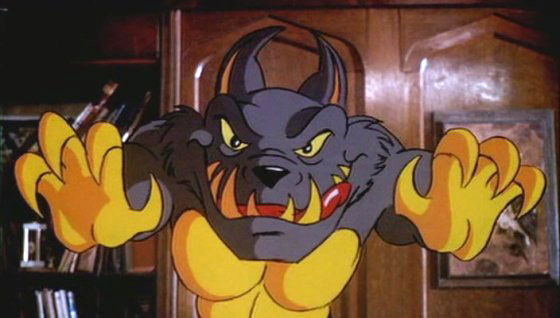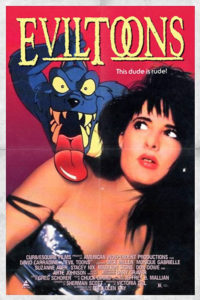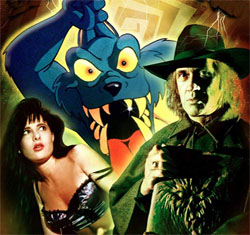
Evil Toons is a 1992 B-horror exploitation movie made by the notorious Fred Olen Ray (Hollywood Chainsaw Hookers, Scream Queen Hot Tub Party, Attack of the 60 Foot Centerfold and dozens more) on a minimal budget that featured buxom, barely clad young women trapped in an old house and menaced by a cartoon demon.
At the beginning of the film, they open an old book that includes the drawing of a monster that comes to animated life and possesses one of the women after using its lengthy tongue to snap off her bra. Typical low-budget horror film chaos ensues.
It was shot in eight days (using equipment and crew from another production) at the cost of $140,000 using “short ends” (unused film left over from other productions). The animation in the film is very limited to just a shot of the monster materializing out of the book and taking over one of the women and then at the end when it is exorcised out of the woman. However, the film trailer makes it appear that there is animation throughout the entire movie.
At the end of the film, a neighbor (Arte Johnson) brings by a portable television set so the women could watch Saturday morning cartoons and they scream after what they have been through the previous night. Like most of Ray’s films, it was made with tongue firmly planted in cheek but the title and concept were wasted on this cheaply and quickly made film.
“After watching Who Framed Roger Rabbit, I left the theater thinking that a clever, resourceful producer could possibly make a picture like it for a very low cost if planned carefully,” Ray stated in an interview that appeared in the book The New Poverty Row (McFarland). “I wrote up a quick outline for a sexy horror comedy called Evil Toons and sent it off to producer Roger Corman who thought it was too risky. Most people thought that anything remotely like Roger Rabbit would cost a fortune in animation costs alone and nothing I said could change their minds.”
 Finally, Ray was able to convince Paramax Pictures producer Vicki Till that he could make the film cost effectively by utilizing equipment, set and crew from another film he was working on at the time called The Millennium Countdown (later re-titled Camp Fear).
Finally, Ray was able to convince Paramax Pictures producer Vicki Till that he could make the film cost effectively by utilizing equipment, set and crew from another film he was working on at the time called The Millennium Countdown (later re-titled Camp Fear).
Ray was looking for Corman to invest $250,000 but a skeptical Corman told him that he didn’t think Ray could mix animation and live action for that price and have it look any good. Ray thought differently and approached other studios but ended up financing much of the film himself because he believed he could do it. Ray wrote (under his pseudonym “Sherman Scott”) and directed the film. He also supplied the voice for the cartoon monster.
“I thought, ‘I’m going to do it just like they do Friday the 13th’. You don’t see Michael Myers in the first Halloween but for a second, a beat here and there,” said Ray on the 20th anniversary of the film. “He’s not on screen for a ton of time. I thought I’ll approach it like that, so then I had to turn (the cartoon monster) into a (live action) girl so there could be a little bit more action. It would’ve been better with more money but I definitely think the cartoon interaction came off successfully. I wasn’t disappointed in that.
“It was a simple story. A group of college girls are hired to clean up an old house and they discover an ancient book made of human skin and accidentally unleash a horrible drawing from it that lives in cartoon form until he takes over a human. One by one they fall prey to the toon until the ghost of the house’s previous occupant played by David Carradine shows up to help them out. My girlfriend at the time, Suzanne [Ager] was in that as well as Arte Johnson and Dick Miller. It had a good cast I thought.

“It was all rather harmless escapist fare with a terrific gimmick of an animated cartoon monster interacting with the live action characters. The process of working the animation and keeping the costs within reason became the major stumbling block in the production.
“I studied the different aspects of creating animation and compositing the images so that I could deal knowledgeably with the different companies working in the field. I decided to split the work up over several companies and deal with each of them on an individual basis. I did that so that I could control every phase of the process and understand what each of them was doing and control any runaway costs.
 “I hired horror artist Chas Balun, eliminating the need for an animation company to create the cartoon monster. Our usual title and roto-effects man Bret Mixon would do the rotoscoping at Gene Warren’s Fantasy II. I would then send the edited 35mm work print and roto drawings to Mark Heller’s Streamline Films in New York and they would do the actual cel animation and inking, sending the work back to us when completed.
“I hired horror artist Chas Balun, eliminating the need for an animation company to create the cartoon monster. Our usual title and roto-effects man Bret Mixon would do the rotoscoping at Gene Warren’s Fantasy II. I would then send the edited 35mm work print and roto drawings to Mark Heller’s Streamline Films in New York and they would do the actual cel animation and inking, sending the work back to us when completed.
“We would then take the art to Keniaction compositing on an aerial-image camera stand. This process works well but because it can only photograph animation that is one cel deep, it requires that no ‘hold’ or multilayered animation shots be used which increased the workload at Streamline.
“A special camera with three pin registration was needed to insure a rock-steady background plate for animation. We used a Panavision Mark II that was weighted down for each scene in order to stop any unwanted movement during the shot.”
At the end of the film, the monster says “I’ll get you in the sequel” because there were hopes that the concept might spark a franchise.
 Ray told interviewer Fred Topel in 2014, “There was (a hope for a sequel) because those were real animation cels. That was before everything was so easy (with CGI). That was “Tom and Jerry” type plastic sheets, thousands and thousands of paintings. I said all you have to do is switch the background out and this animation would work over another scene. Except for the ones that had rotoscope parts missing, you could reuse a lot of these sequences by changing the background plate to another location. So I kept them forever and then I just finally threw them out.”
Ray told interviewer Fred Topel in 2014, “There was (a hope for a sequel) because those were real animation cels. That was before everything was so easy (with CGI). That was “Tom and Jerry” type plastic sheets, thousands and thousands of paintings. I said all you have to do is switch the background out and this animation would work over another scene. Except for the ones that had rotoscope parts missing, you could reuse a lot of these sequences by changing the background plate to another location. So I kept them forever and then I just finally threw them out.”
I reached out to animator Mark Heller – a regular reader here on Cartoon Research. Here were some of his recollections:
“Fred did a great job for his money. He hired all the right people… pros who knew what they were doing.
The live action was directed well for the inclusion of the animation. The rotoscope drawings were done correctly.
I oversaw the animation, in New York, which was done by John Dilworth and Miguel Martinez Joffre (Venture Bros)- one of his first assignments.
“My regular ink and paint person refused to work on it due to the nature of the film! I shipped the art back to LA and the animation cameraman and optical house had no problem. All in all, it was a fun, smooth job.
“It was low budget but people liked it. Years later I was in a Blockbuster on Broadway and they were running it on the in-store monitors. I told the 20-something female employee that I worked on it – and she told me the whole
staff loves it.”


 Jim Korkis is an internationally respected animation historian who in recent years has devoted his attention to the many worlds of Disney. He was a columnist for a variety of animation magazines. With his former writing partner, John Cawley, he authored several animation related books including The Encyclopedia of Cartoon Superstars, How to Create Animation, Cartoon Confidential and Get Animated’s Animation Art Buyer’s Guide. He taught animation classes at the Disney Institute in Florida as well as instructing classes on acting and animation history for Disney Feature Animation: Florida.
Jim Korkis is an internationally respected animation historian who in recent years has devoted his attention to the many worlds of Disney. He was a columnist for a variety of animation magazines. With his former writing partner, John Cawley, he authored several animation related books including The Encyclopedia of Cartoon Superstars, How to Create Animation, Cartoon Confidential and Get Animated’s Animation Art Buyer’s Guide. He taught animation classes at the Disney Institute in Florida as well as instructing classes on acting and animation history for Disney Feature Animation: Florida.




















































It’s a shame Ray threw the cels away. He could have sold them to collectors for thousands.
He’d certainly make back possibly more than he put into this film at the start!
What if I told you I had a massive collection of the original animation cels that I got at an estate sale? What would be the best way to sell them?
Interesting to hear John Dilworth worked on it. I wondered who animated it. I liked the film. It had a Bakshi feel to it. It reminded me of the Italian film Volere Volare.
@Judd I’d suggest listing them in ebay auctions in the Production Art category.
I’ll set up a search alert for ‘Evil Toons cel’ so I’ll know if you ever list them.